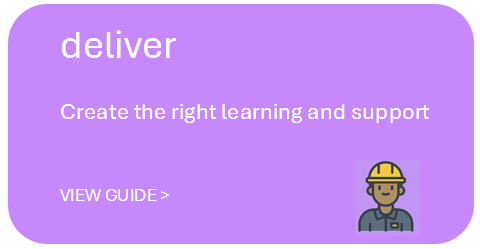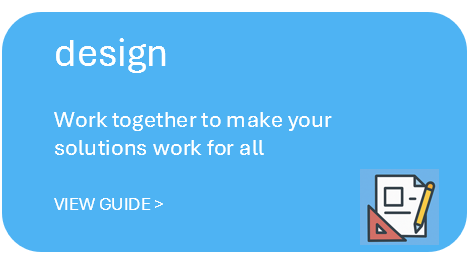Introduction
Getting system settings and partners working in sync is about how best to ensure that employers, tertiary providers and other partners are on the same page before you get started.
Degree-Level Apprenticeships (DLAs) are successful when employers, tertiary providers, and other partners start with a shared understanding of their respective roles, responsibilities, and constraints. While broader policy, funding, and QA levers are addressed in the Enabling Framework, this section is about getting ready to act locally by aligning intentions, processes, and teams across organisations that want to make a DLA work now.
Early alignment reduces duplication, prevents misunderstandings, and builds the trust required for joint decision-making throughout the apprenticeship journey. This is not a formal negotiation process but rather it’s about informal, purposeful conversations that ensure everyone is heading in the same direction.
What this involves
Key steps include:
Clarifying what a DLA is (and is not)
Understanding how your existing systems and processes can support DLA implementation
Identifying the right people inside your organisation to lead or contribute
Building early-stage relationships with key partners
Agreeing on a shared purpose and mutual expectations
Employers
Your role: You are the primary workplace for the apprentice, where most of the learning and support will happen. You’re also part of the co-design and co-delivery partnership that underpins a successful DLA.
What to align internally:
Explore whether DLAs are a good fit for your business. Check out our DLA Readiness Self-Assessment checklist for Employers.
HR and operational teams: Understand that recruitment and supervision of a DLA apprentice is not the same as a typical hire or intern.
People development / L&D: Consider how the DLA integrates with existing staff development pathways or succession planning.
Business unit leads: Identify the types of work and supervision support that will enable applied learning.
What to align externally:
Start conversations with a tertiary provider, your Industry Skills Board or the professional or industry association for your sector to explore whether this is the right approach for your context.
Clarify what roles you can offer, what support you expect from the TEO, and how you will stay involved through the learning journey.
What to expect:
DLAs are relatively new in New Zealand even if they are widely used overseas. You might find that you have to advocate for other partners to support this opportunity, but our DLA Champions can help support you with advice and solutions.
Tertiary providers
Your role: You provide the academic qualification, lead the design of the learning model, and support learner success, while working in active partnership with employers.
What to align internally:
Make sure you are ready for DLAs: Check out our DLA Readiness Self-Assessment checklist for Tertiary Providers.
Programme leaders and academic staff: Need to understand how work-based learning will be embedded and assessed.
Operations and enrolment: Will need to adjust processes to support non-traditional student journeys, such as employer-initiated admissions.
Pastoral and academic support teams: Will need to coordinate with employers to understand learner context and support needs.
What to align externally:
Begin open dialogue with potential employers: share examples, agree on shared goals, and identify what workplace capacity exists.
Engage with ISBs, and professional or industry associations for guidance on qualification relevance, workforce demand, and industry expectations.
Industry Skills Boards, Professional Bodies, and Industry Associations
Your role: You provide advice on qualification settings, occupational standards, and workforce needs, and help connect industry and education partners.
What to align internally:
Professional registration pathways: Look for opportunities for people to obtain professional registration or membership through DLAs.
Skills and qualifications teams: Identify where a DLA model is appropriate and how vocational pathways, qualifications and accreditation processes might need to adapt.
Workforce intelligence and strategy teams: Bring forward sector data, supply–demand forecasts, and quality signals from employers.
What to align externally:
Broker early alignment conversations between employers and providers.
Provide clarity on what makes a programme occupation-relevant and industry-backed.
Identify key points of alignment between academic learning and professional or industry standards (e.g. for registration, regulation, or licensing).
Promote the DLA model as a pathway to address equity and workforce development goals.
Learners and Whānau
Your role: As future apprentices or support people, your aspirations, needs, and expectations are central to the design and delivery of a successful DLA. DLAs are relatively new in New Zealand, even if they are widely used overseas. Ask your employer (if you are employed) or talk to your tertiary provider about whether these options exist and are right for you.
What to align:
Understanding of what a DLA involves: It’s not a traditional degree, and it’s not just a job. It’s both.
Awareness of commitment: DLAs require balancing work, study, and personal life. Having the right support at home and work is key.
Clarity on pathways: Know how the DLA connects to your long-term career, earnings, and further education goals.
Confidence to engage: Learners and whānau should feel included in early information sessions and supported in decision-making.
What to expect:
Employers and providers working together to ensure your success
Support systems at both work and study covering academic help, cultural connection, wellbeing care
Clear communication about expectations, rights, and responsibilities
Tools and Templates
You can use the following tools and resources to support alignment conversations:
DLA Readiness Self-Assessment checklist for Tertiary Providers
DLA Champions can advise you on whether DLAs are a good option
What comes next?
Once your organisation or partnership is aligned, you can move confidently into the Explore phase where you test the opportunity, validate learner demand, and confirm that a DLA is the right fit.
If your alignment work uncovers system-level barriers or questions about funding, programme approval, or QA, refer back to the Enabling Framework for advice on how these can be addressed.
The DLA toolkit
Guidelines
-

Guide for employers
An introduction to degree-level apprenticeships for employers
-

Guide for apprentices
An introduction to degree-level apprenticeships for learners
-

Guide for TEOs
An introduction to degree-level apprenticeships for tertiary education organisations











